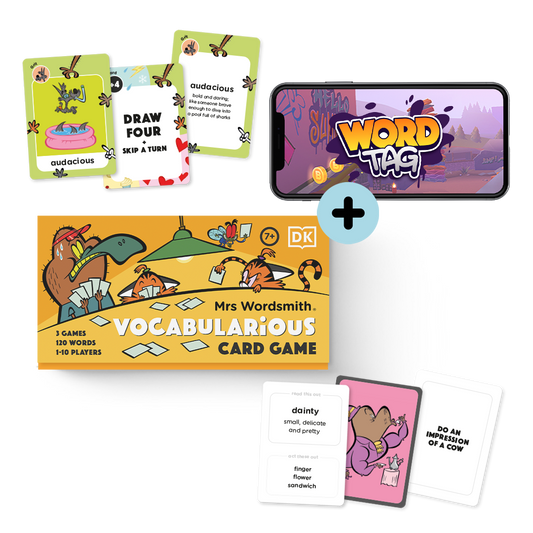Do your kids spend hours building virtual worlds in Minecraft or exploring Roblox? You might wonder if these platforms offer any real educational value. The truth is, when it comes to learning games for kids, fun and education don’t have to be opposites—in fact, the best educational games are built on fun-first principles. In this blog, Mrs Wordsmith explains why making learning games enjoyable is essential for kids’ engagement, motivation, and long-term success.
Table of Contents:
- What Makes a Learning Game Go Viral?
- Fun-First Design: The Key to Real Learning
- How Mrs Wordsmith Makes Learning Games Kids Love
- Engaging Characters Kids Connect With
- Reward Systems That Motivate
- Laughter and Comedy Boost Memory
- Variety Keeps Kids Engaged
- Exploration and Agency Drive Deeper Learning
- Why Fun-First Learning Games Work
- Conclusion
What Makes a Learning Game Go Viral?
Some learning games become instant hits, while others gather dust. The difference? Successful educational games for kids put fun at the heart of their design. Too many learning games feel like “broccoli dipped in chocolate”—dry educational content with a thin layer of fun on top [1]. These games are often designed for adults, not the kids who are supposed to play them. As a result kids lose interest fast, and the learning never sticks.
Fun-First Design: The Key to Real Learning
When we attended an ASU + GSV Summit, experts agreed: a game must be genuinely fun before it can deliver any educational value. Games like Minecraft and Roblox succeed because they give kids autonomy, creativity, and a sense of agency [2]. When kids are excited to play, they’re also more open to learning. As one panelist put it, “A real game is when you try to meet certain learning objectives within the constraints and rules that a game has, rather than adding some gamification elements onto something that’s clearly not a game”.
How Mrs Wordsmith Makes Learning Games Kids Love

At Mrs Wordsmith, we believe educational resources should always be fun-first. Our mission is to create games that not only help kids succeed in school, but also spark a lifelong passion for learning. Our digital vocabulary game, Word Tag, is designed with this philosophy at its core. Here’s how we blend fun and learning to create irresistible educational games for kids:
1. Engaging Characters Kids Connect With
Word Tag features a cast of lovable animal characters that guide kids through vocabulary challenges. Research shows that kids form bonds with fictional characters, boosting motivation, empathy, and memory retention [3]. Characters with human-like qualities make learning feel like a shared adventure, not a solo chore [4].
2. Reward Systems That Motivate
Kids earn coins and unlock cool outfits and upgrades as they progress through the game. These rewards trigger dopamine in the brain, making learning feel satisfying and encouraging kids to keep playing—and learning [5].
3. Laughter and Comedy Boost Memory
Comedy isn’t just fun; it’s a powerful learning tool. Funny examples and silly character interactions make new vocabulary more memorable and enjoyable. Comedy requires kids to think, process, and remember, leading to deeper learning [6].
4. Variety Keeps Kids Engaged
Word Tag exposes kids to new words in multiple contexts—through games, quizzes, and exploring a vibrant virtual world. This variety prevents boredom and helps cement vocabulary in long-term memory. Kids learn best by doing, not just remembering [7].
5. Exploration and Agency Drive Deeper Learning
Word Tag is built around exploration and missions, giving kids control over their learning journey. This hands-on approach nurtures curiosity, resilience, and a love of discovery. In a safe game environment, kids can experiment, make mistakes, and try again—without the fear of failure.
Why Fun-First Learning Games Work
When educational games are designed with fun at the forefront, kids are more likely to play, engage, and absorb new information. The same elements that make games fun—rewards, variety, comedy, and exploration—also make them powerful learning tools. By putting kids’ enjoyment at the middle of the action, we create learning experiences that are both effective and unforgettable.
Conclusion
Fun-first learning games are the future of education. By making games that kids genuinely want to play, we unlock their natural curiosity and set them up for lifelong success.










 https://mrswordsmith.com
https://mrswordsmith.com
Comment
Leave a comment